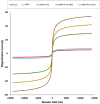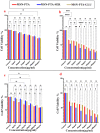A comparative study of sericin and gluten for magnetic nanoparticle-mediated drug delivery to breast cancer cell lines
- PMID: 39103485
- PMCID: PMC11300879
- DOI: 10.1038/s41598-024-69009-y
A comparative study of sericin and gluten for magnetic nanoparticle-mediated drug delivery to breast cancer cell lines
Abstract
With breast cancer emerging as a pressing global health challenge, characterized by escalating incidence rates and geographical disparities, there is a critical need for innovative therapeutic strategies. This comprehensive research navigates the landscape of nanomedicine, specifically focusing on the potential of magnetic nanoparticles (MNPs), with magnetite (Fe3O4) taking center stage. MNPs, encapsulated in biocompatible polymers like silica known as magnetic silica nanoparticles (MSN), are augmented with phosphotungstate (PTA) for enhanced chemodynamic therapy (CDT). PTA is recognized for its dual role as a natural chelator and electron shuttle, expediting electron transfer from ferric (Fe3+) to ferrous (Fe2+) ions within nanoparticles. Additionally, protein-based charge-reversal nanocarriers like silk sericin and gluten are introduced to encapsulate (MSN-PTA) nanoparticles, offering a dynamic facet to drug delivery systems for potential revolutionization of breast cancer therapy. This study successfully formulates and characterizes protein-coated nanocapsules, specifically MSN-PTA-SER, and MSN-PTA-GLU, with optimal physicochemical attributes for drug delivery applications. The careful optimization of sericin and gluten concentrations results in finely tuned nanoparticles, showcasing uniform size, enhanced negative zeta potential, and remarkable stability. Various analyses, from Dynamic Light Scattering (DLS) and scanning electron microscopy (SEM) to transmission electron microscopy (TEM), Fourier Transform Infrared Spectroscopy (FTIR), X-Ray diffraction analysis (XRD), and Thermogravimetric analysis (TGA), provide insights into structural integrity and surface modifications. Vibrating Sample Magnetometer (VSM) analysis underscores superparamagnetic behavior, positioning these nanocapsules as promising candidates for targeted drug delivery. In vitro evaluations demonstrate dose-dependent inhibition of cell viability in MCF-7 and Zr-75-1 breast cancer cells, emphasizing the therapeutic potential of MSN-PTA-SER and MSN-PTA-GLU. The interplay of surface charge and pH-dependent cellular uptake highlights the robust stability and versatility of these nanocarriers in tumor microenvironment, paving the way for advancements in targeted drug delivery and personalized nanomedicine. This comparative analysis explores the suitability of silk sericin and gluten, unraveling a promising avenue for the development of advanced, targeted, and efficient breast cancer treatments.
Keywords: Breast cancer; Chemodynamic therapy; Drug delivery; Gluten; Magnetic nanoparticles; Nanomedicine; Protein-based nanocarriers; Silk sericin; Targeted therapy; pH-responsive.
© 2024. The Author(s).
Conflict of interest statement
The authors declare no competing interests.
Figures












Similar articles
-
Enhancing Cisplatin Efficacy with Low Toxicity in Solid Breast Cancer Cells Using pH-Charge-Reversal Sericin-Based Nanocarriers: Development, Characterization, and In Vitro Biological Assessment.ACS Omega. 2024 Mar 12;9(12):14017-14032. doi: 10.1021/acsomega.3c09361. eCollection 2024 Mar 26. ACS Omega. 2024. PMID: 38560009 Free PMC article.
-
Codelivery of resveratrol melatonin utilizing pH responsive sericin based nanocarriers inhibits the proliferation of breast cancer cell line at the different pH.Sci Rep. 2023 Jul 8;13(1):11090. doi: 10.1038/s41598-023-37668-y. Sci Rep. 2023. PMID: 37422485 Free PMC article.
-
Chitosan/agarose-encapsulated oleic acid-coated magnetite nanoparticles as a chemotherapeutic-loaded scaffold for drug delivery: Physico-chemical and in vitro biological characteristics.Int J Biol Macromol. 2025 Jun;311(Pt 1):143409. doi: 10.1016/j.ijbiomac.2025.143409. Epub 2025 Apr 24. Int J Biol Macromol. 2025. PMID: 40286971
-
Pharmaceutical applications of silk sericin.Ann Pharm Fr. 2020 Nov;78(6):469-486. doi: 10.1016/j.pharma.2020.06.005. Epub 2020 Jun 20. Ann Pharm Fr. 2020. PMID: 32569621 Review.
-
Advancing Nanomedicine Through Electron Microscopy: Insights Into Nanoparticle Cellular Interactions and Biomedical Applications.Int J Nanomedicine. 2025 Mar 8;20:2847-2878. doi: 10.2147/IJN.S500978. eCollection 2025. Int J Nanomedicine. 2025. PMID: 40078651 Free PMC article. Review.
Cited by
-
Recycled Sericin Biopolymer in Biotechnology and Bioelectronics.Bioengineering (Basel). 2025 May 20;12(5):547. doi: 10.3390/bioengineering12050547. Bioengineering (Basel). 2025. PMID: 40428166 Free PMC article. Review.
-
Sericin-coated MnO2@CeO2 nanocatalysts enable pH-responsive and synergistic vincristine delivery for lung cancer therapy.Sci Rep. 2025 Jul 11;15(1):25048. doi: 10.1038/s41598-025-10182-z. Sci Rep. 2025. PMID: 40646082 Free PMC article.
-
Precision nanomedicine: navigating the tumor microenvironment for enhanced cancer immunotherapy and targeted drug delivery.Mol Cancer. 2025 Jun 3;24(1):160. doi: 10.1186/s12943-025-02357-z. Mol Cancer. 2025. PMID: 40457437 Free PMC article. Review.
-
Recent Insights into the Potential and Challenges of Sericin as a Drug Delivery Platform for Multiple Biomedical Applications.Pharmaceutics. 2025 May 26;17(6):695. doi: 10.3390/pharmaceutics17060695. Pharmaceutics. 2025. PMID: 40574008 Free PMC article. Review.
References
Publication types
MeSH terms
Substances
LinkOut - more resources
Full Text Sources
Medical
Research Materials
Miscellaneous

